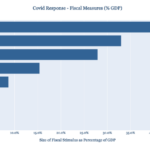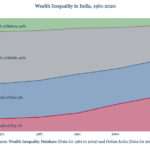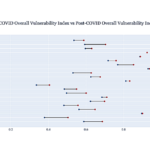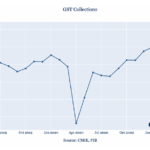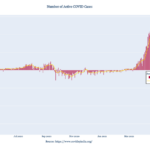Covid-19 setback: The strongest reversal in India’s battle against extreme poverty
In January 2020, just as the world was hearing about the outbreak of Covid-19 in Wuhan, China, the World Bank forecast that the global economy would grow by 2.5% in the calendar year 2020. This year in January, the World Bank estimates for the global economy suggest a contraction of 4.3%. This includes an estimate of 2% growth in China and 9.6% contraction in India. In January 2020, the World Bank forecast for India in 2020-21 was at 5.8%
According to the Pew Research Center, this severe global economic downturn not only diminished the growth in global middle class but led to a reduction in absolute numbers. It led to a sharp increase in the numbers of those classified as poor (see Figure 1 below). The Pew Research Center’s report is based on World Bank data.
Figure 1 Source : Pew Research Center
Source : Pew Research Center
Who is middle class:
“The population in each global region is divided into five groups: poor, low-income, middle-income, upper-middle-income, and high-income. The poor live on $2 or less daily, low-income on $2.01-$10, middle-income on $10.01-$20, upper-middle-income on $20.01-$50 and high-income on more than $50. All dollar figures are expressed in 2011 prices and purchasing power parity dollars, currency exchange rates adjusted for differences in the prices of goods and services across countries.”(Pew Research Center)
Why the report raises concerns about India
According to the report, while the drop in middle-class numbers was centered in South Asia and East Asia and Pacific, the jump in the number of poor was centered in South Asia (especially India) and Sub-Saharan Africa. In fact, South Asia experienced the largest decrease in middle class numbers and the highest increase in the number of poor in 2020. (See Figure 2 below). In South Asia, the January 2020 World Bank forecast1 for the Indian economy was growth of 5.8% in 2020-21. One year later, the World Bank estimates suggest 9.6% contraction in 2020. For Bangladesh, the 2020-21 forecast was pegged at 7.3% and January 2021 estimates for the year 20202 was revised to 2%.
The result of the global slowdown has been a 32 million reduction in middle class in South Asia and 78 million growth in the count of poor.
Figure 2 Source : Pew Research Center
Source : Pew Research Center
The Pew Research Center drills down further to analyze the impact of the Covid-19 pandemic on India and China’s middle class. Owing to India and China’s large populations (one-third of global population), the changes in these two countries have an outsized impact on global numbers. World Bank’s January 2020 forecast for India and China GDP growth was 5.8% and 5.9% respectively. In January 2021, these were revised to -9.6% for India and 2% for China.
As a result of this extreme reversal in India’s case, Pew Research Center’s analysis estimates that India’s middle-income population (earning $10.01-20 daily) shrunk by 32 million. This was 60% of the global decrease in middle-income population (54 million). At the same time, China saw its middle-income population decrease by only 10 million but the number of poor in China increased by only 1 million (see Figure 3 below). In February 2021, the Chinese President, Xi Jinping had announced that China had succeeded in ending extreme poverty.
Figure 3
The gap between India and China
China’s GDP was $14.28 trillion in 20193 and India’s GDP was $2.89 trillion4 . While both countries have similar population sizes, the per capita income presents a different picture (see Figure 4 below). According to World Bank data, China had a per capita income of $10,217 in 2019, while India’s per capita income was only $2,100 or barely one-fifth. This does not present the whole picture when it comes to the difference between how the population in these two Asian countries is distributed and how it was affected in a pandemic year.
According to January 2020 estimates, India should have had 87% of its population in the low-income category while China should’ve had 44% of its population in this category. According to pre-pandemic forecasts, India’s middle-income population was anticipated to be 99 million in 2020 but the pandemic pushed this number down to just 66 million. For China the anticipated number was 504 million (5 times more than India) and the pandemic pushed it down by nearly 10 million. So, while India saw its middle-income population decline, it saw a jump in the category of people classified as poor (more than doubling from an anticipated 59 million to 134 million).
While more than 80% of India’s population is categorized as low-income, this number is less than 50% for China. As China announced an eradication of extreme poverty, the economic slowdown and the Covid-19 pandemic saw India’s poor increase to 9.7% of the population.
In China, the middle-income, upper-middle-income and high-income categories constitute 54% of the entire population (down from 56%, as anticipated before the pandemic) while this number is a mere 6.1% in India (down from the pre-pandemic forecast of 9%). This puts in sharp contrast the difference between the two economies with similar population sizes.
Figure 4
A big reversal: How Covid-19 hurt India’s fight against poverty
Pew Research Center’s analysis of data from World Bank’s PovcalNet database highlights India’s success in poverty alleviation between 2011 and 2019. At the same time, this analysis shows that during the same period, China was highly successful in not only ending extreme poverty but also increasing its middle-income, upper-middle-income and high-income population.
India reduced the number of poor people from 340 million in 2011 to 78 million in 2019, a decline of 262 million. This number was expected to decline further to 59 million in 2020 but ended up increasing to 134 million. This represents the biggest reversal in India’s fight against extreme poverty.
Figure 5 (below) also highlights the stark difference between the Indian and Chinese economic situation. While India pulled out 262 million out of extreme poverty, China added 264 million to its middle-income population.
India’s middle-income population increased from 29 million in 2011 to 87 million in 2019 but the pandemic has seen this number decline to 66 million in 2020. We do not see this in case of China.
Figure 5
This analysis by Pew Research Center shows the damage done to the Indian economy and livelihoods by the Covid-19 pandemic in 2020. At the start of another fiscal year, India is seeing a sharp rise in Covid-19 infections which is being called the second wave. This analysis points to the dangers of the pandemic continuing to wreak havoc on the Indian economy for an extended period.
1Global Growth: Modest Pickup to 2.5% in 2020 amid Mounting Debt and Slowing Productivity Growth (World Bank, January 2020)
2World Bank’s January 2020 forecast for India was on the basis of fiscal year while the January 2021 estimate for the year 2020 is on the basis of calendar year.
3https://data.worldbank.org/country/China
4https://data.worldbank.org/indicator/NY.GDP.MKTP.CD?locations=IN
If you wish to republish this article or use an extract or chart, please read CEDA’s republishing guidelines.



